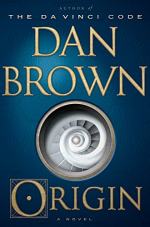
|
| Name: _________________________ | Period: ___________________ |
This test consists of 15 multiple choice questions and 5 short answer questions.
Multiple Choice Questions
1. What did Winston tell Langdon his real name was in Chapter 8?
(a) Tom.
(b) Roger.
(c) Jack.
(d) Art.
2. Where was the Superconducting Super Collider located, according to Kirsch in Chapter 20?
(a) Texas.
(b) New Mexico.
(c) Florida.
(d) Nevada.
3. How many people were watching the presentation remotely, according to a screen in the auditorium in Chapter 12?
(a) 2 million people.
(b) 6 million people.
(c) 9 million people.
(d) 10 million people.
4. Who was the father of the heliocentric model?
(a) Galileo Galilei.
(b) Charles Darwin.
(c) Albert Einstein.
(d) Nicolaus Copernicus.
5. What is the Spanish word that means computer?
(a) Moederbord.
(b) Ordenador.
(c) Rkenaar.
(d) Calque.
6. What Jewish religious leader did Kirsch meet with in the Prologue?
(a) Rabbi Yehuda Köves.
(b) Rabbi Luis Ávila.
(c) Rabbi Ambra Vidal.
(d) Rabbi Diego Garza.
7. In what century did the city of Baghdad rise to prominence as the greatest center of learning on earth?
(a) The 8th century.
(b) The 3rd century.
(c) The 12th century.
(d) The 10th century.
8. What color was Edmund Kirsch's phone that Langdon took from his jacket?
(a) Magenta.
(b) Turquoise.
(c) Green.
(d) Red.
9. What serves as the inciting incident which sets off the rising action of the novel?
(a) The murder of Langdon.
(b) The introduction of Winston.
(c) The arrest of Ambra.
(d) The murder of Kirsch.
10. What symbol appeared on the Uber car next to the Uber sticker?
(a) The infiniity symbol.
(b) The papal cross.
(c) The Jewish star.
(d) The Nazi swastika.
11. Who was the ultraconservative dictator that ruled Spain for 36 years?
(a) Federico Fellini.
(b) Benito Mussolini.
(c) Francisco Franco.
(d) Adolf Hitler.
12. Where did Winston instruct Langdon and Ambra to go that caused Langdon to argue with him in Chapter 39?
(a) Across a rickety bridge.
(b) Into a train tunnel.
(c) Across a hayfield.
(d) Into an airplane hangar.
13. What Guardia Real agent set out in pursuit of Kirsch's killer after the fact in Chapter 21
(a) Diego Garza.
(b) Paloma Calvo.
(c) Rafa Diaz.
(d) Joaquim Beña.
14. To what deity did the Greeks attribute the ocean's tides?
(a) Poseidon.
(b) Artemis.
(c) Athena.
(d) Hera.
15. What did Kirsch write on the business card he gave to Langdon and told him to give to any taxi driver after the presentation and they would know where to take him, in Chapter 9?
(a) ECO-RTW343.
(b) BIO-EC346.
(c) BIO-RTS432.
(d) SCI-4534.
Short Answer Questions
1. On what highway was the Uber traveling toward Madrid that carried Avila in Chapter 29?
2. What word refers to the notion that life on earth was seeded from another planet by a meteor or cosmic dust?
3. From what website does the excerpt in Chapter 18 come?
4. Where was the Spanish artist Maruja Mallo from?
5. Where did the security woman tell Agent Fonseca that Ambra and Langdon were located via his phone in Chapter 28?
|
This section contains 458 words (approx. 2 pages at 300 words per page) |

|




